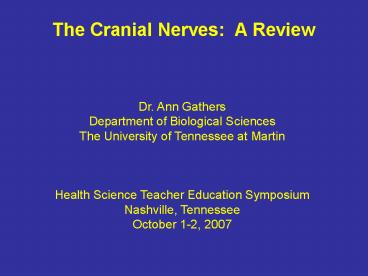The Cranial Nerves: A Review - PowerPoint PPT Presentation
1 / 25
Title:
The Cranial Nerves: A Review
Description:
Athletes and Cranial Nerves Contact sports have the highest incidence of nerve ... Optic Oculomotor Trochlear Trigeminal ... Bell s Palsy Auditory ... – PowerPoint PPT presentation
Number of Views:205
Avg rating:3.0/5.0
Title: The Cranial Nerves: A Review
1
The Cranial Nerves A Review
Dr. Ann Gathers Department of Biological
Sciences The University of Tennessee at
Martin Health Science Teacher Education
Symposium Nashville, Tennessee October 1-2, 2007
2
(No Transcript)
3
Athletes and Cranial Nerves
- Contact sports have the highest incidence of
nerve injuries. - In the US, approximately 1/3 of diagnosed nerve
injuries were related to football trauma. - Others included wrestling, weight-lifting, and
baseball and softball (regional differences)
4
- 12 Pairs of Peripheral Nerves
- Originate in or near the brain
- Sensory, Motor, and Mixed
- Voluntary, Involuntary, and Mixed
5
Olfactory (I)
Optic (II)
Oculomotor (III)
VENTRAL VIEW
Trochlear (IV)
Trigeminal (V)
Facial (VII)
Abducens (VI)
Auditory (VIII)
Glosso- pharyngeal (IX)
Spinal Accessory (XI)
Vagus (X)
Hypoglossal (XII)
6
Oculomotor
Facial
Optic
Trochlear
Olfactory
Glossopharyngeal
Vagus Glossopharyngeal
Auditory
Trigeminal
Abducens
7
Spinal Accessory
Hypoglossal
8
Oh Olfactory (I) Once Optic (II) One
Oculomotor (III) Takes Trochlear
(IV) The Trigeminal (V) Anatomy Abducens
(VI) Final Facial (VII) Very Vestibulocochlear
(VIII) Good Glossopharyngeal (IX) Vacations Vagus
(X) Seem Spinal accessory (XI) Heavenly Hypoglo
ssal (XII)
9
Functions
10
Olfactory (I)
- Provides sense of smell
- Damage causes impaired sense of smell
11
Optic (II)
Optic (II)
- Provides vision
- Damage causes blindness in visual field
12
Oculomotor (III)
- Some eye movement, opening of eyelid (innervates
all extraocular muscles except lateral rectus
superior oblique) - Constriction of pupil (parasympathetic)
- Focusing
- Damage drooping eyelid (ptosis), dilated pupil,
double vision (diplopia), difficulty focusing
inability to move eye in certain directions
13
Trochlear (IV)
- Provides eye movement
- Damage causes double vision (diplopia)
inability to rotate eye downward and outward
14
Trigeminal (V)
15
Trigeminal (V)
- Three Branches
- Opthalmic
- Maxillary
- Mandibular
- Main sensory nerve to face (touch, pain and
temperature) and muscles of mastication - Damage produces loss of sensation impaired
chewing
16
Abducens (VI)
- Provides eye movement (lateral rectus)
- Damage results in inability to rotate eye
laterally at rest eye rotates medially
(strabismus cross-eyed)
17
Facial (VII)
- Facial expressions
- Taste on anterior 2/3s of tongue,
- Salivary glands and tear, nasal palatine glands
- Damage sagging facial muscles (ptosis and
corner of mouth droops) and disturbed taste (no
sweet salty sensations) - i.e. Unilateral sagging facial muscles
- Bells Palsy
18
Auditory/ Vestibulocochlear (VIII)
- Provides hearing sense of balance
- Damage produces deafness, dizziness, nausea, loss
of balance nystagmus
19
Glossopharyngeal (IX)
- Provides control over swallowing, salivation
(parotid), gagging, sensations from posterior 1/3
of tongue, control of BP and respiration
(receptors in carotid) - Damage results in loss of bitter sour taste
impaired swallowing (dysphagia)
20
Vagus (X)
21
Vagus (X)
- Provides swallowing, speech, regulation of
viscera (somatic and visceral) - Damage causes hoarseness or loss of voice,
impaired swallowing (dysphagia) - i.e. Neurocardiogenic Syncope
- relatively new diagnosis
- fainting spells
22
Spinal Accessory (XI)
- Swallowing, head, neck shoulder movement
- Damage impaired head, neck shoulder movement,
head turns towards injured side
23
Hypoglossal (XII)
24
Hypoglossal (XII)
- Tongue movements of speech , food manipulation
swallowing - Damage inability to protrude tongue if
bilateral damage - deviation towards injured side ipsilateral
atrophy if unilateral damage - i.e. Dysarthria
- poor articulation
25
Thank You































